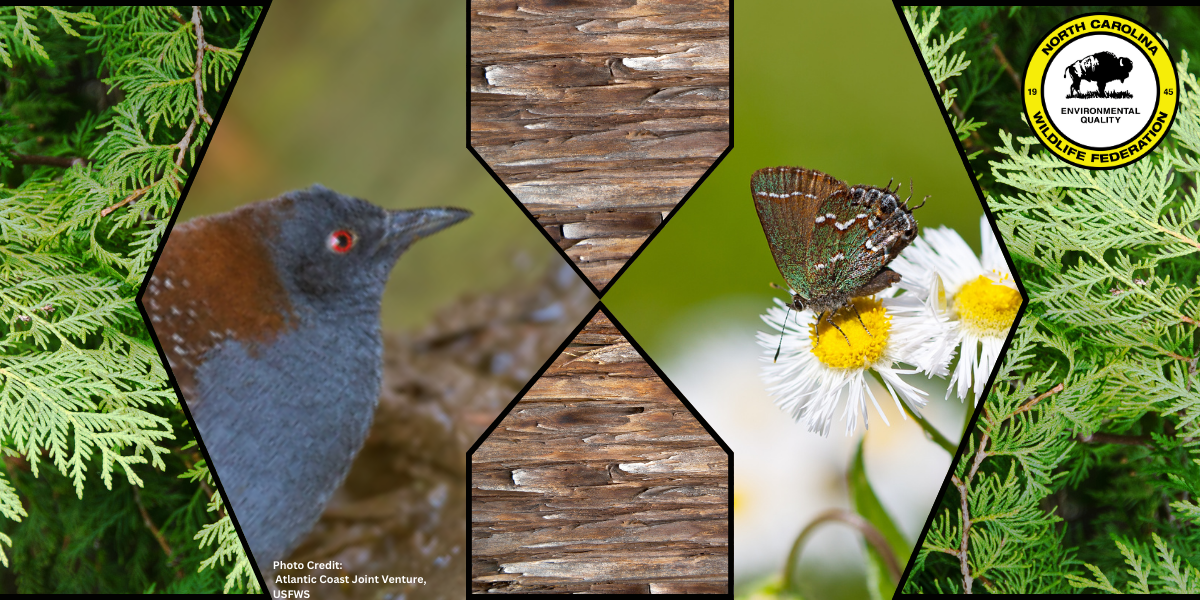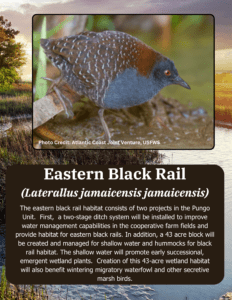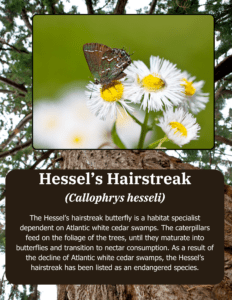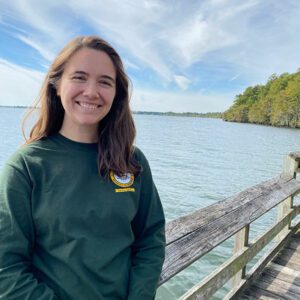Birds, Butterflies, and Cedars – Millennium Forest and Atlantic White Cedar Project

Find out more about NC pollinators through NCWF’s March, 2024: March for Pollinators.
NCWF, in partnership with the U.S. Fish and Wildlife Service’s Coastal Program, is working to improve habitat for the eastern black rail, a bird species federally listed as threatened. The project will also restore Atlantic white cedar, a threatened forest ecosystem, to portions of its historic range on Pocosin Lakes National Wildlife Refuge.

The eastern black rail habitat consists of two projects in the Pungo Unit. First, a two-stage ditch system will be installed to improve water management capabilities in the cooperative farm fields and provide habitat for eastern black rails. In addition, a 43 acre block will be created and managed for shallow water and hummocks for black rail habitat. The shallow water will promote early successional, emergent wetland plants. Creation of this 43-acre wetland habitat will also benefit wintering migratory waterfowl and other secretive marsh birds.
Thirty acres of Atlantic white cedar will be restored to historical ranges on two sites on prior converted cropland. One site will be located adjacent to the Red Wolf Center in Columbia and will improve upon a previous restoration project. Walking trails and informational panels, translated in both English and Spanish, on the benefits of habitat restoration will be installed within the area. The second site will be located on the highly visited Pungo Unit. Both projects will serve as demonstration sites to educate refuge visitors, local school children and community members.
7,000 Juniper Project
In 2000, Pocosin Arts School of Fine Craft introduced the 7,000 Juniper Project to celebrate the beginning of the third millennium. The purpose of the project was to engage the citizens of Eastern North Carolina in the restoration of the endangered Atlantic white cedar ecosystem by planting 7,000 seedlings within a designated site at Pocosin Lakes National Wildlife Refuge that would be known as the Millennium Forest. Each tree was planted with a hand-made clay “millennium marker” to provide the opportunity for participants to honor something about themselves, their community or this special time in history. The first planting took place on March 20th, 2000 with the help of artists, educators, scientists, boatbuilders and poets. This event also presented an opportunity for participants of all ages and backgrounds with a gathering to share their thoughts and feelings regarding the forest, trees, loss, restoration and community.

During March 2024, NCWF is celebrating “March For Pollinators”, celebrating critical pollinators across North Carolina, such as the Hessel’s Hairstreak.
24 years later, another revitalization project is about to take place in the Millennium Forest. An additional 12 acres of what was previously converted farm fields will be transformed into Atlantic white cedar forest to help restore this tree within its historic range. Here, it will provide crucial wildlife habitat and opportunities for recreation and education for the surrounding community.
Why Atlantic White Cedar?
Atlantic white cedar, also commonly known as Juniper, is a species of conifer tree that is native to the coastal plain region of North Carolina. The historic range of the tree encompasses the coastal plain regions from Maine south to Florida and west to Mississippi where the cedars thrive in freshwater swamps, such as pocosins, bogs, and along stream sides. Throughout the 1800 and 1900s, cedar forests were logged intensively for their valuable wood products. North Carolina’s Atlantic white cedar forests have struggled to bounce back due to significant changes in their natural range including drainage of wetland areas, other land objectives, and lack of fire. Atlantic white cedar forests provide habitat to species that solely depend on this tree for survival, such as the Hessel’s hairstreak butterfly whose caterpillars rely on Atlantic white cedar stands as their hosts. Because Atlantic white cedar forests provide critical habitat for a diverse range of mammal, bird, reptile, amphibian and insect species, NCWF partnered with Pocosin Lakes National Wildlife Refuge to increase this threatened habitat through a large-scale tree planting project.
How can you get involved?
For questions regarding how you can get involved in community wildlife projects across Northeastern NC, please contact NCWF’s Refuge Conservation Coordinator, Laura Frazier at laura@ncwf.org.
Written by:

-Laura Frazier, Refuge Conservation Coordinator

